Quiet Healing Time after a Long Tunnel of Recovery:
One Couple’s Templestay at Gwaneumsa on Jeju Island
Text by. Yu Chang-seon Photo by. Ha Ji-kwon
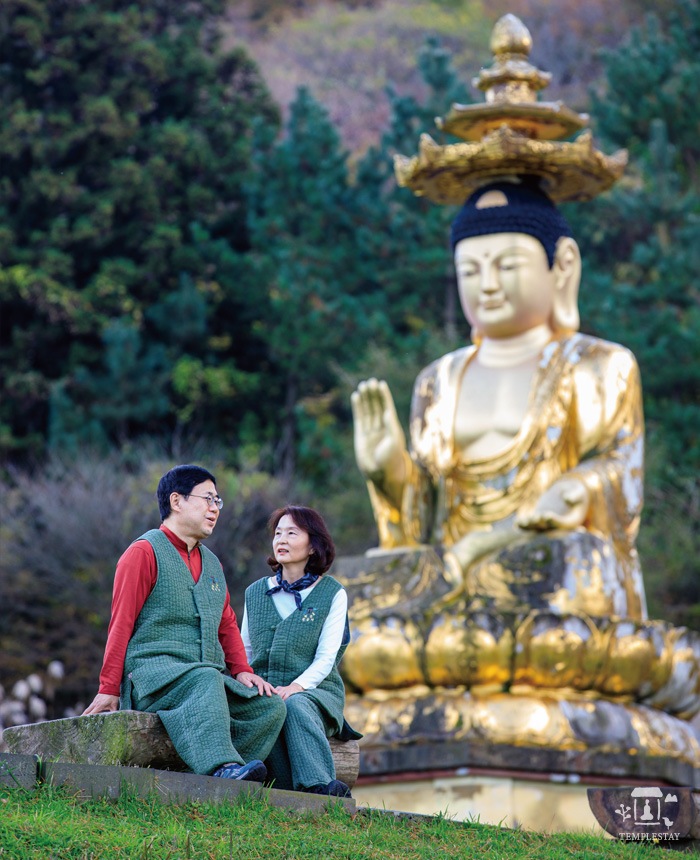
This is the first year I began participating in Templestay programs. Previously, I had visited temples all over Korea while traveling, but only well-known temples. Even then, I neither explored them to any great extent nor entered their dharma halls to offer prostrations.
Beginning Templestay Pilgrimages This Year
I have been to several Templestay programs this year. I started at Cheoneunsa Temple on Mt. Jirisan, then Beopjusa Temple on Mt. Songnisan, and Songgwangsa Temple in Suncheon. Then, on November 14, I went to Gwaneumsa Temple on Jeju Island, so I have been to four Templestays in one year.
Why did I suddenly start attending Templestays so often? I had brain tumor surgery in February 2019, a major surgery that was potentially fatal. Fortunately, the surgery went well and the tumor was 100% removed. However, I suffered from severe aftereffects, and my body felt like it had been hit by a bomb, after which I endured a long tunnel of fighting illness and rehabilitation.
I’ve heard that many people have a change of outlook on life after overcoming such a potential life and death crisis. I too began to realize the finiteness of life, so my attitude toward the rest of my life changed. In the second part of my life, after being close to dying, I wanted to live a quiet, peaceful life, distancing myself from the world’s hatred, conflicts, envy, and jealousy.
So, at the late age of 60-plus, I became absorbed in enjoying culture and art, which gradually helped comfort and heal me. The reason I wanted to experience a Templestay was an extension of that. I wanted to spend time in a quiet temple and absorb the compassionate energy of the buddhas to heal my body and mind.
Of course, my body has already recovered a lot now, which enables me to visit many more temples and participate in Templestays. However, my health issues are still ongoing. I still need to take care of my health, heal my body and mind, and regain my strength.
Templestays gave me a feeling I had never experienced before. First of all, I like the profound feelings that temples deep in the mountains give me. Their unparalleled scenery gave me precious time to heal myself, who had previously been too busy living and working in the city. The charm of a Templestay is that each temple has its own unique flavor.
When I go on a Templestay, I enter the dharma hall and prostrate myself before the buddhas. My most sincere prayer at that time is for the restoration of my health. One day while prostrating myself, I looked closely at the face of the buddha statue. Buddha statues may have been crafted by people, but this particular buddha’s face looked so kind. It seemed like the buddha would grant any wish I made.
When I go to a temple, I always go into the Medicine Buddha Hall, if there is one, and offer prostrations. The Medicine Buddha Hall enshrines the Medicine Buddha who takes care of the sick. Of course, from a medical perspective, praying to the Medicine Buddha probably won’t cure me. However, if I go into either the Daeungjeon or Medicine Buddha Hall and pray, I somehow believe my body will get better. Perhaps it is the healing power of the temple I feel in my heart.
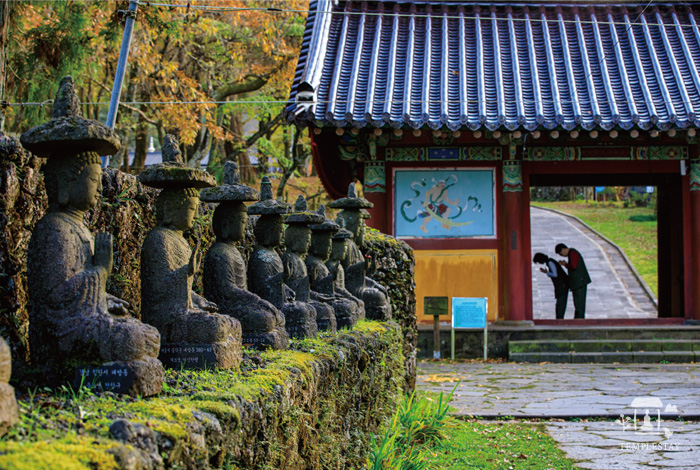
Yearning for a Templestay on Jeju, the Island of Healing
I wanted to go to Gwaneumsa Temple on Jeju for my last Templestay of the year. Previously, I had only been to temples located on large mountains on the mainland. A Templestay on Jeju, surrounded by the sea, seemed like it would be a different experience. In fact, I had visited Jeju often since being discharged from the hospital about 5 years ago. I even lived there for a month to help me recover, surrounded by beautiful scenery. And whenever I had time, I would often hike Jeju’s well-known Olle Trail. To me, Jeju was an island of healing.
Because I live in Seoul, getting to Gwaneumsa Temple is quite a journey, requiring me to take a plane from Gimpo Airport to Jeju. However, the fact that Gwaneumsa Temple is located at the foot of Mt. Hallasan, and close to the entrance to the Mt. Hallasan Trail, is a big attraction. My wife (Kim Gyeong-suk) and I took an early morning flight to Jeju, arrived early, and drove a rental car to the Gwaneumsa Trail trailhead. Since we had a few hours to kill before our Templestay began, we decided to climb up Mt. Hallasan a short distance to get some exercise.
We climbed an easy path so as not to disrupt our Templestay program and arrived at Gwaneumsa Temple on time. Being able to climb Mt. Hallasan both before and after our Templestay was one advantage the Gwaneumsa Templestay offered.
When we arrived at Gwaneumsa Temple and entered the One Pillar Gate, our eyes were drawn to one particularly beautiful path. It led to the Gate of Four Heavenly Kings and was so unique and beautiful that it was used as a filming location in the popular Korean TV drama Extraordinary Attorney Woo. We went to the temple office, unpacked our luggage under the guidance of a staff member, and changed into our Templestay uniforms. On our visit to Songgwangsa Temple this past October, we wore light clothing, but now that it was November, we chose thicker winter clothes.
Then, we looked around Gwaneumsa Temple under the guidance of the staff member. Since it was the day for students to take the national college entrance exam, many parents were praying all day long at Daeungjeon Hall. Our children were now all grown, but we went to Daeungjeon Hall anyway and briefly offered our prostrations. When I go to a temple, I usually go to the Medicine Buddha Hall to pray for my health, but Gwaneumsa Temple does not have a Medicine Buddha Hall. Instead, the Mountain Spirit, Big Dipper God, and Sage Hermit are enshrined together in the Hall of Three Sages. After hearing that the Medicine Buddha is also enshrined in this hall, we offered our prostrations. The huge Maitreya Buddha and numerous stone buddhas behind the hall caught my eye, the mountains and reeds in the forest behind them adding to the charm of the temple in late autumn.
What I learned from the staff member, a living witness to the history of Gwaneumsa Temple, was that Gwaneumsa Temple was restored in 1909 by a nun named Haewol Seunim, thus reestablishing Buddhism on Jeju, which had been inactive for 200 years since the late Joseon Dynasty. I was able to appreciate the significance of the restoration when I saw the Activity Monument of Haewoldang Bongnyeogwan and her statue. I also went into Haewolgul, a cave where Haewol Seunim is said to have prayed and meditated for four years.
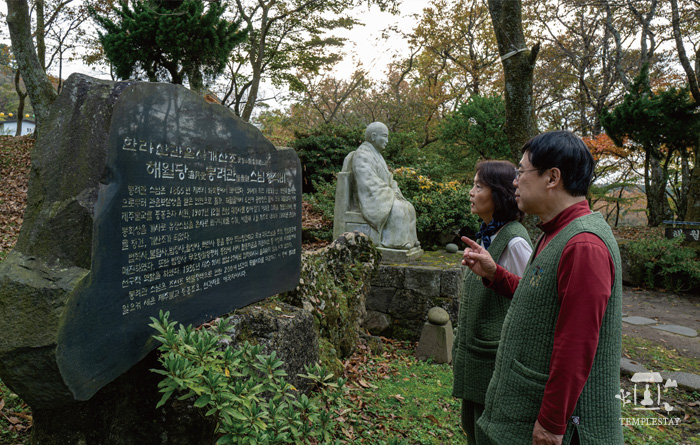
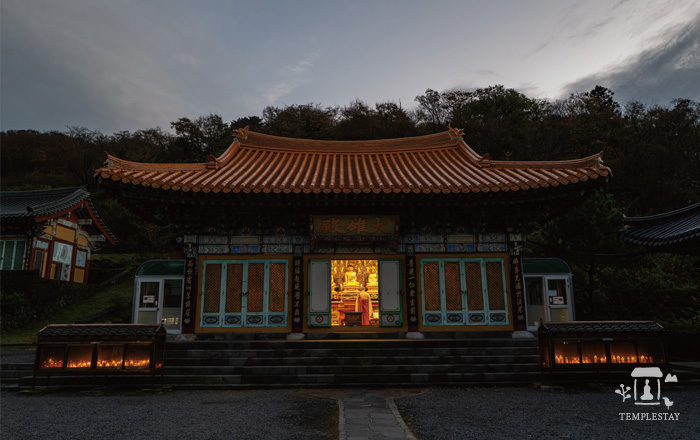
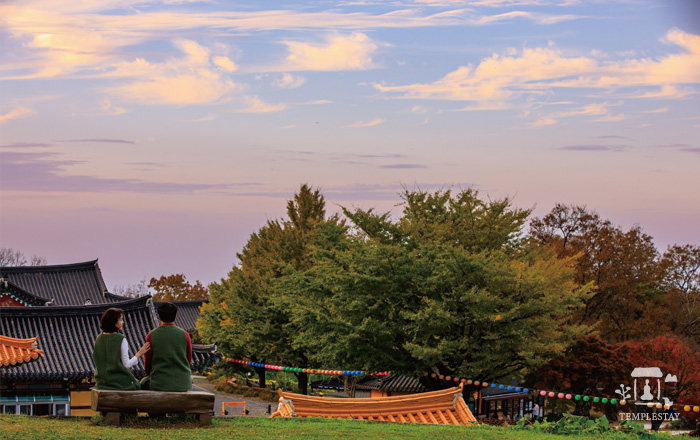
The Simple and Comfortable Atmosphere of Gwaneumsa Temple
My wife and I only looked around for a short time, but the atmosphere of Gwaneumsa Temple was simple and comfortable. Unlike grander, larger temples, it is not very large and does not have many dharma halls, but neither does it feel small, and its unique atmosphere was pleasant. And since it is located on the tourist hotspot of Jeju, it radiates a welcoming atmosphere that anyone can approach comfortably. I usually admire the grandeur of large temples with a long history, but the feeling of Gwaneumsa Temple with its unique flavor was very pleasant in another way.
The next morning, we were able to have a “conversation over tea with a monk,” a common Templestay program. Since there were no other Templestay participants that day, a nun graciously joined us for tea. She was Boryun Seunim, who oversees the Templestay program at Gwaneumsa Temple. She started by telling us about Gwaneumsa Temple and then asked about our lives. I told her about a dilemma I had been holding in my heart recently.
“After I almost died and left the hospital, my outlook on life changed. I decided to live a quiet and peaceful life. However, as I came to realize the finiteness and preciousness of life, there were more and more things I wanted to do. Now that I am over 60, I have opened my eyes to the world of culture and art, and I see and hear much more. Due to the aftereffects of my surgery, I retired from broadcasting, which had been my lifelong career, and began to write. In order to write a good article with inner conviction, I have to study a lot. This keeps me constantly busy, and I sometimes wonder if this is an obsession.”
I was afraid Boryun Seunim would tell me that too was a form of greed and that I should discard it. Instead, she gave me words of encouragement and said, “That is not an obsession, it’s a role. If you welcome your writings as something that helps people live better, then the effort to write well can be considered a good role. When you eventually depart this world, the influence your writings leave on others can be considered positive.”
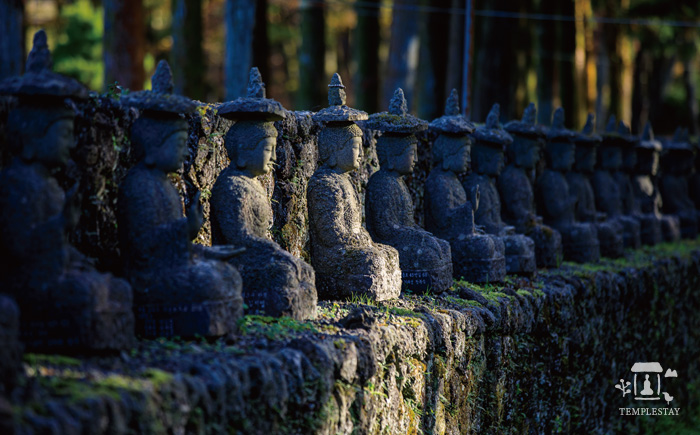
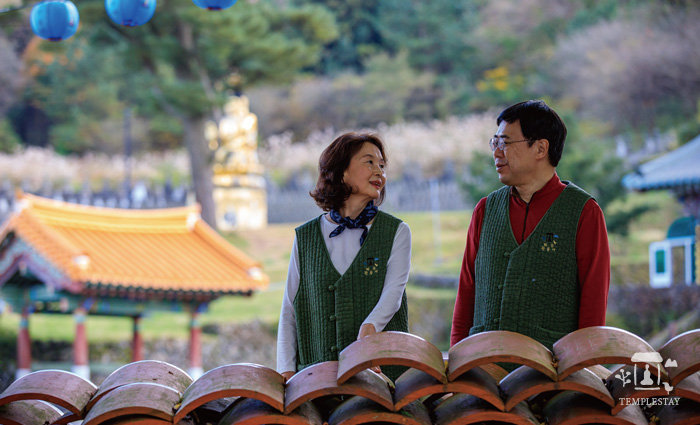
Participate in a Templestay when Feeling Heavy-hearted and Tired
Our conversation over tea took longer than expected. I know very well how much energy it takes to listen to the hardships of others who come to a Templestay, and then give them advice that is somewhat different from counseling. I felt sorry and said, “You must be busy, so we should go now.” But Boryun Seunim said, “But you came a long way to be here. Let’s talk a little more,” and we continued talking.
As our conversation drew to a close, Boryun Seunim emphasized the importance of “being aware.” Just as we turn on our windshield wipers when it rains to see the road ahead clearly, she said that we should live life with a clear goal, and not forget our goal even in difficult circumstances. Concluding our conversation, she emphasized, “You should also come to a Templestay with an awakened mind.”
Just as she advised, I think being aware is an important attitude toward life, regardless of one’s age. In particular, as we get older, there are often times when we stop growing and cultivating our minds. But the effort to become a better human being is the reason for our existence, and we must devote ourselves to this goal until the end of our lives.
Through our conversation with Boryun Seunim, I learned that many people come to Templestays because they are having a hard time. They have their own unique set of worries, and many of them want a monk or nun to give them advice.
When people think of a Templestay, they often think of it as just a tourist program for people with money. However, looking back on my own Templestay experiences this year, not just at Gwaneumsa Temple, I realized that people came to a Templestay with their own individual problems. These include people battling cancer, having a hard time at work, not being able to get over depression, single young women looking for hope in a difficult situation, etc. I realized that everyone has some difficulties in life, and that everyone has at least some worry in their heart.
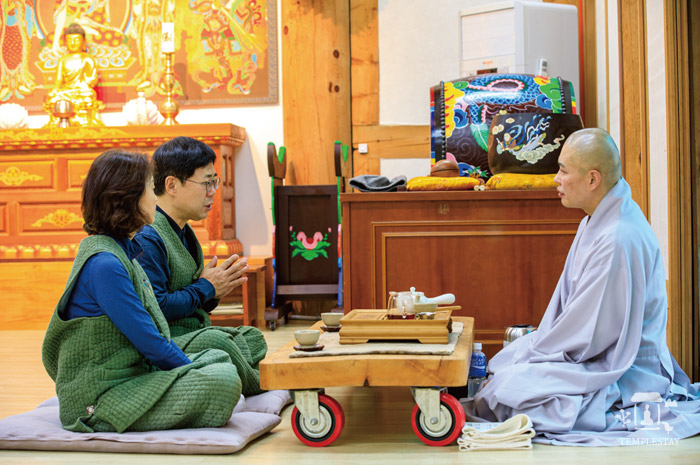
More People Should Learn about and Try a Templestay
I hope that Templestay programs, which can offer comfort and provide healing to one’s heart, will become more revitalized. Now, I hear that Templestays are said to be very popular, but I see many people around me who only talk about going but keep putting it off. Templestay programs should be promoted better so that people come to see them as more user-friendly, and that each temple will eventually offer better programs.
What I thought was unfortunate was that Gwaneumsa Temple, located in a prime location at the foot of Mt. Hallasan, was unable to expand its Templestay program to accommodate more visitors. In order to accommodate more participants like other large temples, a new Templestay building would have to be built, which led to financial issues. Jeju is a special self-governing province, so it is the only province in Korea that operates independently and is 100% responsible for its finances without government subsidies. So, realistically, it was highly unlikely that financial support to build a new Templestay building at Gwaneumsa Temple would be forthcoming.
I was very disappointed when I heard that. Many foreign tourists also visit Jeju, and I think it is a great program for foreigners to experience Templestay culture when they visit here. In addition, many people come here to sightsee and take the Gwaneumsa Trail to climb Mt. Hallasan. If they could also experience Gwaneumsa’s Templestay program at the same time, it would be a good opportunity to take care of both body and mind in one visit. Unfortunately, that probably won’t happen in the near future.
After this winter passes, I will continue to attend Templestays next year. This year, 2024, was a year when I discovered a new life-fulfilling interest: which temple to visit next.
Yu Chang-seon had briskly interacted with the world. He wrote and published columns for various media outlet and wrote articles. Since he began battling his illness, he had shared the beauty of culture and art with warm-hearted writings. His books published in Korean include Art Encounterd for the First time at Fitfy and Time to Find Myself. In December 2024 he passed away at age 64.
Gwaneumsa Temple
+82-10-5219-8561




